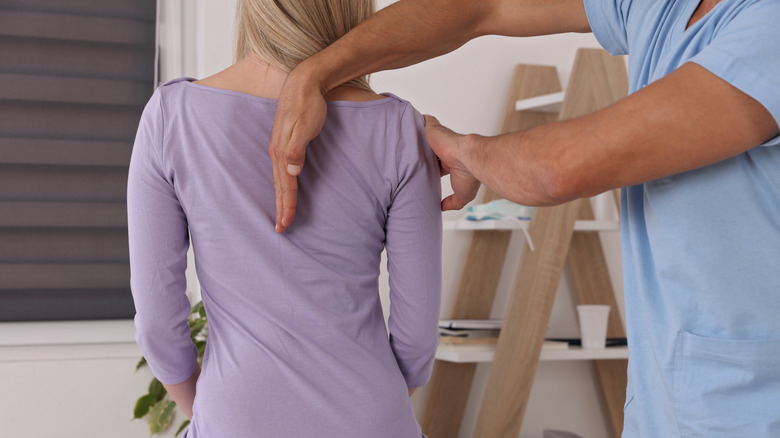How To Fix The Hump On The Back Of Your Neck
After a long day at work you probably find yourself slumped over your computer, shoulders curved in and back hunched. Your head is raised as you finish up on your laptop and man, is your back killing you. When you finally finish you sit up and stretch, then run your hand down your neck to work out some tension. When you do, your hand might just slide over a hump at the base of your neck, one that's always there and seems to be getting worse.
That is commonly known as the Dowager's hump, named for the stereotype that it happens mostly among elderly women. The medical term for it is kyphosis, and it has a whole lot more to do with the way you hunch over your computer than you probably think.
Certain conditions like birth defects, spinal malformations, and osteoporosis can cause kyphosis. But the vast majority of cases are caused by bad posture, according to Cleveland Clinic. When you hunch forward over a device (or any sort of detail work on a project) and round your shoulders, you stop engaging a group of muscles known as thoracic extensor muscles. Over time these muscles become weak, leading to worse posture and the dreaded hump.
Posture is the priority
Kyphosis will get worse as you get older. To prevent this, it's critical to change the habits that started its development in the first place. When interviewed by Cleveland Clinic, Dr. Frederick Wilson, DO, explained that kyphosis becomes irreversible if left for too long. The hump can be reduced but not removed. And even when it is reversible, he cautioned, treatment can take months depending on the treatment method.
Mild forms are usually treated through physical therapy. But as the Mayo Clinic explains, some forms can compress the lungs and digestive tract, leading to severe problems. These cases may be treated through surgery or the use of braces.
Less severe cases are best treated through therapy that strengthens the thoracic extensor muscles, as well as your back, according to Dr. Wilson.
One exercise is the chin tuck. Pull your chin straight back like someone is pushing something into your face. Another exercise is to squeeze your shoulder blades together, engaging your upper back. You can also perform wall push-ups in a corner or inside a door frame, lowering your chest past your hands when you lean in.
Dr. Wilson generally refers his patients to physical therapists so they can learn the proper form for these exercises. It's a good idea to get a referral if you can. But until then, there are a few things you can do. Sit up straight, pull your shoulders back, and keep your head high for a stronger back, healthier neck, and a little boost of confidence.


